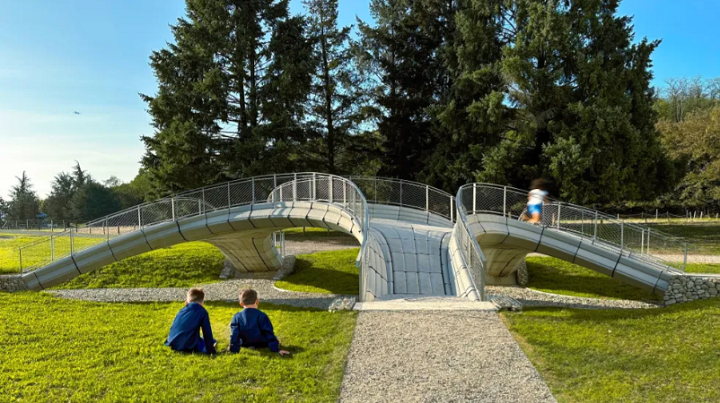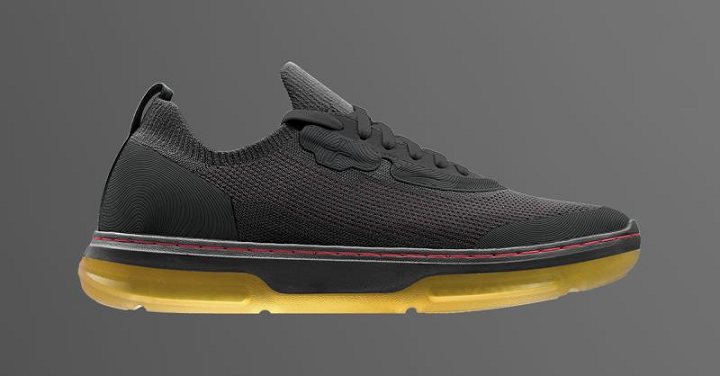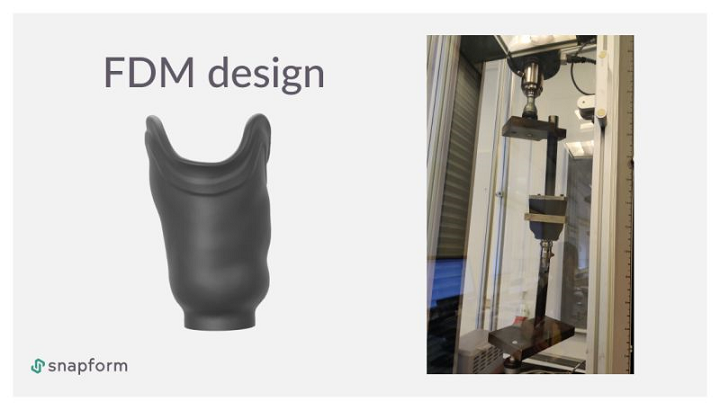3D Printing News Briefs, February 3, 2024: 3D Printed Bridge, Furniture, Prosthetic Sockets, & More – 3DPrint.com
We’re beginning with molecular design and 3D microprinting analysis in the present day, earlier than shifting on to a robotic 3D printer partnership. Then it’s on to a wide range of functions, together with a 3D printed concrete bridge, 3D printed furnishings, 3D printed shoe soles, and eventually 3D printed prosthetic sockets.
Researchers Use Molecular Design for Additive 3D Microprinting

Consultant SEM photographs of 3D microstructures printed with 2PLP with alternating (blue), triblock (crimson), and block (grey) oligomer inks printed with 0.25 wt.% DETC demonstrating versatility of the oligomers as inks for 3D microprinting. Scale = 10 µm. (Reprinted with permission from Wiley-VCH Verlag)
Yow will discover macromolecules with complicated, outlined constructions in nature, however not usually in artificial macromolecules. Sequence-defined approaches allow extra exact management of the macromolecular construction, however apart from area of interest sectors like knowledge encryption, there aren’t many functions. However, a workforce of researchers from Heidelberg College and the Max Planck Institute for Medical Analysis used rational molecular design to direct sequence-defined supplies as 3D printable inks. By combining two-photon laser printing (2PLP) on the microscale with sequence-defined macromolecules, they may program print decision, mechanics, and fabrication limits to develop exact, intricately structured supplies.
The researchers formulated three inks by synthesizing oligomers, and used them to 3D print very intricate “buckyball” constructions. Utilizing sequence-based management to dictate the print behaviors, the workforce then microprinted intricate vegetation, mammals, and birds. By “manipulating the positioning of photocrosslinkable items alongside an oligomer spine,” they had been in a position to program main variations within the topology, print decision, mechanics, and fabrication home windows of the microscale prints. This skill to make use of sequence design to tailor 3D printable inks has many potential functions for setting up specialised units, corresponding to focused drug supply autos, lab-on-a-chip and bio-integrated electronics, labeled cell progress scaffolding, and even molecular circuit parts. You possibly can be taught extra about their work of their printed paper.
TGS Providing Flexbot Analysis XL for Czech Republic Clients

Flexbot Analysis XL platform put in at TGS. Photograph Credit score: TGS
Dutch firm CEAD, a pioneer in robotic massive format additive manufacturing (LFAM) options, introduced a partnership with superior engineering agency TGS, situated in Mýto, Czech Republic. At an open home in December, TGS launched its new Flexbot Analysis XL platform, which the CEAD workforce had put in in September. Attendees bought to see dwell demonstrations of the Flexbot Analysis XL, printing with Airtech Superior Supplies Group’s Dahltram T-100GF fiberglass composite that’s bolstered with recycled-grade co-polyester resin. With a print quantity of as much as 3 x 1 x 2.5 meters and a flexible vary of composite supplies—together with PEEK and glass- or fiber-reinforced—the novel large-format printer will permit TGS to supply 3D printing companies to its prospects within the Czech Republic. Moreover, TGS may even function a reseller for CEAD’s Flexbot and extruders within the nation and different close by areas.
“The open day occasion highlighted as soon as once more the significance of the strategic partnership between CEAD and TGS. This synergy will leverage our competencies to help prospects within the implementation journey for large-format additive manufacturing options in Czeck and Slovakia markets,” mentioned Andrea Baldolini, gross sales workforce lead at CEAD.
Holcim Unveils Round 3D Printed Concrete Bridge

Sustainable constructing options chief Holcim launched a bridge that’s mentioned to be the primary of its sort: Phoenix, a round, 3D printed concrete masonry bridge that stands via compression with out reinforcement. The bridge, situated at Holcim’s Innovation Hub in Europe, was constructed utilizing its proprietary ECOCycle round know-how and a {custom} concrete ink with 10 tons of recycled supplies inside. Holcim partnered with the Block Analysis Group at ETH Zurich, Zaha Hadid Architects Computation and Design Group, and incremental3D to create the bridge, which demonstrates how combining round building and 3D concrete printing can allow low-carbon infrastructure functions. As Holcim defined, “Phoenix resulted from the partial recycling of aggregates” from the unique blocks of 3D concrete printed bridge Striatus, launched by these similar companions through the 2021 Venice Biennale of Structure.
“I’m thrilled to unveil Phoenix, a monument to sustainability and the results of a fruitful collaboration with our companions to satisfy a typical objective: demonstrating that important infrastructure will be designed and in-built a means that’s round and lowcarbon in the present day,” said Edelio Bermejo, Head of World R&D, Holcim. “This undertaking showcases the affect that innovation can have in Holcim’s mission to decarbonize constructing for a net-zero future.”
OZRUH Launches Furnishings Assortment Made with 3D Printed Sand

London-based architectural design agency OZRUH, based in 2019, creates designs which might be novel and clever and, because it states on the web site, “made by the rules of divergent evolution, superior computational processes, and modern manufacturing methods.” Its newest furnishings assortment undoubtedly matches—every bit in PRIMITIVES [1] is 3D printed utilizing recyclable quartz sand particles. Every sculptural, detailed nightstand within the assortment exhibits the agency’s exploration of making voxel-based shell geometries by controlling erosion. The tactic used to print the items is predicated on binder jetting, and the gathering marries modern aesthetics and sustainability. Quartz sand, which will be recycled a number of occasions, is the principle materials, and a dissolvable materials binds the sand with out the usage of excessive temperatures, which improves manufacturing effectivity and helps sustainability.
“The objective is to make designs that blur the distinction between archaeological and geological varieties to intention for higher longevity than typical modernist geometries. Permitting the items to be extra receptive to adapting to sudden situations, exterior pressures, and erosion. This vary of sculptural furnishings demonstrates how we will use 3D printing strategies to push formal experimentation and novelty with new functions of historic supplies to create long-lasting purposeful artwork,” mentioned Levent Ozruh.
“Our studio believes that embracing the thought of antifragility* in architectural design presents a terrific alternative to find new methods to create shapes and constructions whereas additionally making designs extra sustainable. This mind-set is much like how we see pure supplies like rocks as full, even when they’ve some irregularities – differentiating from trendy design, the place even a small chip on a dice’s nook is seen as harm.”
Made Plus Inc Utilizing ETEC Xtreme 8K for Planet-Constructive Footwear

U.S.-based footwear firm Made Plus Inc. (made+), a Desktop Steel buyer, is pioneering planet-positive manufacturing, and utilizing the ETEC Xtreme 8K DLP 3D printer to make footwear. Along with 3D printing, the corporate makes use of machine knitting and digital modeling in its on-demand manufacturing mannequin. Clients can go to the all-in-one product customization platform to select from a whole lot of coloration mixtures for his or her footwear, which provide a alternative of both a traditional polyurethane cushioning system or an unique 3D printed lattice insole. Every pair within the firm’s debut shoe assortment, the Skiff, is made in Maryland, incorporates azo-free dyes, and has a classy, up to date design. Observe made+ on Instagram to get 10% off your subsequent {custom} order with the promo code M+instagram.
“Our modern method to creating footwear not solely ensures high quality, match and efficiency but additionally aligns with a accountable, environmentally acutely aware life-style,” the corporate states on its web site.
“By selecting made+ footwear, you’re making a acutely aware resolution that positively impacts our planet with out sacrificing appear and feel.”
Snapform & Create it Actual 3D Printing Prosthetic Sockets with FDM

Prosthetic clinic Snapform, based mostly on the Technical College of Denmark (DTU), is devoted to bettering the lives of amputees by reimagining learn how to make inexpensive, custom-fitted prosthetics with the newest digital know-how, together with its prosthetic becoming engine SimFit. Just lately, the corporate was excited to share that it’s made optimistic progress in exploring the potential of Fused Deposition Modeling (FDM) as a method to make prosthetic sockets. This technique is normally regarded as not robust sufficient for prosthetics, and plenty of favor to make use of Selective Laser Sintering (SLS) as an alternative. This work took place via a collaboration with fellow Danish firm Create it REAL to analyze and check the capabilities of FDM printing for prosthetic sockets. Snapform performed a energy check on an FDM printed socket made by Create it REAL, and introduced in a LinkedIn publish that “it handed the utmost energy check based on ISO 10328.”
“The potential affect of this achievement is big. With Snapforms Simfit program mixed with Creat It Actual’s printing know-how, there’s a major alternative to dramatically cut back the price of prosthetics. This breakthrough opens doorways for numerous amputees worldwide who at the moment lack entry to high-quality prosthetics.”
Subscribe to Our E mail E-newsletter
Keep up-to-date on all the newest information from the 3D printing trade and obtain data and presents from third get together distributors.